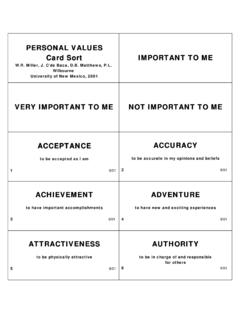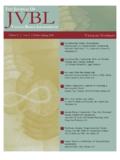Transcription of Comparing Results of Clifton StrengthsFinder (CSF)
1 THE GALLUP ORGANIZATION PRINCETON Comparing Results of Clifton StrengthsFinder (CSF) Myers-Briggs Type Indicator (MBTI) and Values-in- action (VIA) Philip Stone Senior Scientist, The Gallup Organization Professor of Psychology, Harvard University The Myers Briggs MBTI Pioneer test in positive psychology Suddenly became popular (tipped) in the 1970 s Norms available by category for proportion of people in different jobs (but not their happiness in the job). Variant versions on web QuickTime and aTIFF (Uncom pressed) decom pressorare needed to see this StrengthsFinder (CSF) Developed from years of experience using strengths-oriented interviews to match people to jobs. Organized into 34 strengths QuickTime and aTIFF (Uncompressed) decompressorare needed to see this in action (VIA) Partly based on what philosophers wrote on character and virtues Partly builds upon Gallup Wellsprings project as well as psychological research on specific virtues such as gratitude.
2 Sponsored by the Mayerson Foundation and available on-line. QuickTime and aTIFF (Uncompressed) decompressorare needed to see this differences between the instruments MBTI items force choices between two ends of a dimension. Result is a forced opposition of eight categories on four dimensions. VIA uses five-point scales with many reverse scored. Each item relates to one scale. CSF has each item compared against a distracter that is usually not scored in order to avoid creating forced oppositions. Distracter provides a context. Also, some items scored on more than one scale. Questions driving this investigation How do the VIA, MBTI and CSF relate to one another? Are there strengths covered by one instrument that the others miss? If so, what are they? If so, do the three instruments then complement one another to provide to a more comprehensive portrait? If not, are they redundant? This report will show The MBTI serves a useful orienting function to think about one s strengths The VIA and CSF Results complement each other and add richness to a student s self-understanding One test situates some strengths of the other.
3 Example: VIA s Leadership Some strengths have special functions Example: VIA s Zest The MBTI Results identify an area of sparse strengths coverage in both the VIA and CSF Our comparison of the three instruments Information gathered from students in a large (non-required) applied social psychology class at Harvard, with feedback an integral part of the course content. Participants were 39 Freshmen, 43 Sophomores, 80 Juniors and 116 seniors. Most concentrators in economics (25%) psychology (25%), government (19%) VIA and CSF staffs kindly provided scores on each scale, not just the top five scores. Meyers-Briggs type scores mainly from a short on-line version. Many students had taken the MBTI previously and reported the online Results generally agreed with prior testing. Overall CSF Class Profile (2004 shown; 2005 is similar) Top VIA Strengths of Harvard students Judgment, critical thinking and open-mindedness Capacity to love and be loved Kindness and generosity Humor and Playfulness Honesty, authenticity and genuineness Gratitude Curiosity and interest in the world Social intelligence Perspective wisdom Lowest VIA Strengths of Harvard students Modesty and humility Spirituality, sense of purpose, faith Forgiveness and mercy Appreciation of beauty and excellence Self control and regulation: Love of learning Caution, prudence and discretion Distribution of our students compared with MBTI norms MBTI category Student % MBTI norms % Extraversion 54% 60% Introversion 46% 40% Sensing 67% 71% Intuition 33% 29% Thinking 54% 50% Feeling 46% 50% Judging 71% 56% Perceiving 29% 44% MBTI.
4 Sensing vs Intuitive People who prefer Sensing tend to focus on the present and on concrete information gained from their senses People who prefer Intuition tend to focus on the future with a view toward patterns and possibilities. MBTI : Sensing vs Intuitive Make Production Build Experience Sign Literal Prefers realistic people Prefers those who say what they mean. Do in accepted way. Prefer to be conventional Values having commons sense Create Design Invent Theory Symbol Figurative Prefers imaginative people Prefers those with original ways of saying things Invent a way of your own Prefer to be original Values having vision MBTI Types: Judging vs Perceiving People who prefer Judging tend to like a planned and organized approach to life and prefer to have things settled. People who prefer Perceiving tend to like a flexible and spontaneous approach to life and prefer to keep their options open.
5 Example items: Does the idea of making a list of what you should get done over a weekend appeal to you, leave you cold, or positively depress you? Do you find the more routine parts of the day restful or boring? High MBTI judging types are high in these CSF and VIA scales: Achiever t = p = .013 Analytical t = p = .0007 Discipline t = p < .0001 Consistency t = p < .0001 Focus t = p = .0002 Harmony t = p < .0001 Learner t = p = .022 Caution, prudence and discretion t = p .0002 Industry, diligence and perserverence t = p = .0013 Self control and regulation t = p = .0257 High MBTI perceiving types are high in these CSF and VIA scales: Activator t = p = .142 Adaptability t = p = .0001 Command t = p = .0117 Ideation t = p < .0001 Self-assurance t = p = .0076 Strategic t = p =.
6 0005 Woo t = p = .0562 Bravery and valor t = p = .055 Creativity, ingenuity and originality t = p = .0009 Humor and playfulness t = p = .0116 Which instrument do the students find most valuable? MBTI 14% VIA 32% CSF 53% Students often preferred the test that provided what they thought to be the best fit Most prefer more detailed pinpointing of the CSF and VIA. Some complained the CSF was the most aggravating to take. MBTI seen as providing useful overview Column inderVIAC olumn 16E (extrav ersion)I (introv ersion) Introverts prefer VIA Test ChiSquare Prob>ChiSq Likelihood Ratio Pearson N=235 Spontaneous students prefer VIA Column inderVIAC olumn 16J (judging)P (perceiv ing) Test ChiSquare Prob>ChiSq Likelihood Ratio Pearson N =234 Feeling people tend to prefer MBTI Column inderVIAC olumn 16F (f eeling)T (thinking) Test ChiSquare Prob>ChiSq Likelihood Ratio Pearson Only 34 preferred MBTI out of 235 Intuitives slightly tend to prefer MBTI Column inderVIAC olumn 16N (intuition)S (sensing) Only 34 preferred MBTI out of 235; Chart p =.
7 18 To interpret correlations between scales, it is necessary to consider an overall g factor found in our Harvard VIA Results Similar to g as a general intelligence factor, the VIA scales correlate an average of .30 with each other, while the CSF scales only correlate an average of .16 with each other. VIA scales correlate an average of .12 with CSF scales Negative correlations between VIA scales are very rare; more common in CSF. VIA scales that correlated an average of more than .30 with other VIA scales Bravery and valor, .35 Capacity to love and be loved, .34 Curiosity and interest in the world, .37 Fairness equity and justice, .35 Gratitude, .38 Honesty, authenticity and genuineness .33 Kindness and generosity .36 Leadership .37 Perspective wisdom .38 Social intelligence .34 Zest .35 VIA scales that correlated an average of less than .30 with other VIA scales Modesty and humility.
8 07 Spirituality: .20 Creativity, ingenuity and originality: .21 Humor and playfulness: .21 Self control and regulation: .23 Caution, prudence and direction: .24 Appreciation of beauty and excellence: .24 CSF scales that correlate an average of .20 or more with VIA scales are: Achiever .22 Arranger .24 Belief .23 Learner .27 Positivity .20 Relator .20 Responsibility .23 Self assurance .25 Woo .22 CSF scales that correlate an average of about zero ( to +.09) with VIA scales are: Adaptability Analytical Command Competition Context Deliberative Discipline Empathy Consistency Harmony Ideation Individualization Intellection Maximizer Restorative Significance How MBTI & CSF Results shed light on what is VIA Leadership Example VIA leadership items I can always get people to do things together without nagging. (reverse score) I am not very good at planning group activities.
9 In a group, I try to make sure everyone feels included. High leaders score characteristic of these MBTI categories: Extravert t = p = .004 Feeling t = p = .003 VIA s Leadership correlations with CSF scales High correlations Achiever .24 Arranger .37 Learner .24 Positivity .32 Relator .30 Responsibility .24 Self Assurance .22 Woo .23 Low correlations Adaptability .00 Analytical Command Competition Consistency Deliberative Empathy .07 Harmony Ideation Individualization .03 Intellection Maximizer .02 Restorative .01 Significance .01 VIA s Zest as an amplifier for some strengths Example items: I throw myself into everything I do (reverse score:) I mope a lot Zest correlates with Modesty and humility, but an average of .35 with other VIA scales. Correlations especially high with Curiosity and interest in the world (.)
10 64) and Hope optimism and future mindedness. (.66) Correlations of Zest with CSF Scales High correlations: Achiever .39 Activator .40 Arranger .39 Communication .45 Focus .36 Learner .40 Positivity .44 Self assurance .41 Woo .52 Low correlations Adaptability Analytical Deliberative Empathy Consistency Harmony Restorative How VIA virtue scales relate to CSF scales Forgiveness and mercy Correlates with includer .38 Includer item: I accept many types of people. Also correlates with positivity .34 Appreciation of beauty and excellence Correlates with connectedness .40, empathy (.37 and input (.36) Gratitude correlates with: belief (.43), positivity (.38), arranger (.34), developer (.33), responsibility (.32). Generally, those high on an MBTI type are also high on the corresponding VIA and CSF scales True for Introvert, Extravert, Thinking, Feeling, Judging and Perceiving types.





